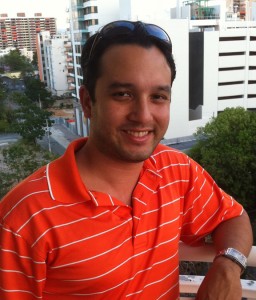
José Punchin-Marrero '99
By Barbara Mulligan
When structural engineer José Punchin-Marrero ’99 was a boy growing up in San Juan, Puerto Rico, he spent much of his time drawing houses and plans for houses. He often helped his uncle mix concrete and prided himself on knowing the perfect combination of cement, sand, gravel, and water.
In retrospect, Punchin sees those hobbies as clear indications of his career path. But at the time, it was not nearly as obvious.
By the time Punchin was in ninth grade, a hospital visit for a broken arm had inspired the notion of studying medicine and becoming an orthopedist like his older cousin. He entered Lafayette intending to major in biology, but after a few courses, realized that while he loved medicine, he did not love the courses he needed to take to get into medical school.
“Math and physics came so easy to me, compared to biology and chemistry,” he says, explaining that the reasons are likely both genetic and environmental: his father, Jorge Punchin ’70, earned a B.S. in mathematics from Lafayette and now heads the graduate mathematics department at Universidad de Puerto Rico.
Punchin, who holds a B.S. degree in civil engineering from Lafayette and an M.S. in civil engineering from North Carolina State University, has worked in a variety of roles for two different North Carolina-based engineering firms and his own consulting business, Renaldo Corp., based in San Juan.
Last year, Punchin found a way to combine his interests in construction engineering and medicine. He returned to San Juan as an engineering project manager for the U.S. Veterans Administration. He oversees designs for new construction, retrofitting, and repair work at VA hospitals and clinics throughout Puerto Rico and the Virgin Islands.
Punchin credits several Lafayette professors for reigniting his interest in construction engineering and for helping him move on to graduate school. He says his academic adviser, B. Vincent Viscomi, now Simon Cameron Long Professor Emeritus of Civil and Environmental Engineering, and Robert S. Mattison, now Marshall R. Metzgar Professor of Art and department head, both fostered his interest in architecture, and Gary P. Gordon, professor of mathematics, helped him realize his potential.
And he points to the destruction of the World Trade Center towers in 2001, the year he earned his M.S. degree, with driving home the value of solid, careful building design.
“There are so many lives in your hands,” Punchin says, noting that many more lives would likely have been lost that September 11 if the buildings had not been so well designed.
Eight years later, during his time as a consultant, Punchin got the opportunity to work at the World Trade Center site, as a vibration mitigation consultant to Tutor Perini Corp., which was blasting through granite to build a foundation for a Port Authority of New York and New Jersey structure near the site.
“It was amazing and gratifying to be part of something so important,” he says.
While Punchin says he enjoyed his three years as a consultant and relished the opportunity to travel, he wanted a more stable life for his wife and family. Now, he’s enjoying his return to the medical world, meeting with doctors and discussing how best to design buildings and rooms to accommodate both patients and state-of-the-art medical equipment.
And he often finds himself describing his work in terms of the human body. “The external part of a building is like the skin. The engineer designs the bones it covers.”
For Punchin, the work is almost always about the people who benefit from it.
“I never forget my sensitivity to life and people,” he says, adding that he feels especially privileged to work for veterans. “They gave a service for us. They sacrificed themselves and put their lives on the line. Now I can give back to them.”
